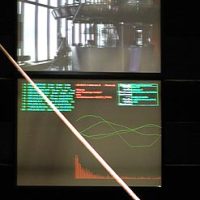“If you understand 2001 completely, we failed. We wanted to raise far more questions than we answered,” said Arthur C. Clarke, author of 2001: A Space Odyssey. The period in which the film was made was the mid-sixties, the age of visions. Soviet and American propaganda came thick and fast about the conquest of space, and not long after the film was first shown, the first man set foot on the moon. Kubrick, Clarke and their colleagues, making use of modern science and the rich arsenal of realistic [fiction], created a large-scale technical and artistic utopia, as a memorial work of this age, which the world is now trying to come to terms with in either a serious of ironic way. Apart from the sci-fi fans, it is now scientists that are again looking at the questions that have remained open: What is still needed in order for computers to be able to lip-read, like HAL 9000? What remains to be developed to have human-computer dialogues like those heard in the film? Can a computer have feelings?
The answers today, already in several fields, do not over-step the borders of reality by much. In 2001 we have arrived at a more sober age than that imagined: the conquest of space, the visions of the expansion of the human borders have been dwarfed by the – imagined or real – nightmare of cloning and the greenhouse effect. The tempo is dictated by (imagined or real) scientific and economic necessity, while in the meantime science [fiction] permeates every part of our everyday lives. The visual world of science [fiction] is one of the most determinant factors of our contemporary environment – without the films, computer games, the daily sci-fi soap operas, certain elements of design, the objects and technical equipment known from science [fiction] literature and films, computers and the Internet, our lives today would be unimaginable.
Science [fiction], which is treated as a stepchild of high art, enjoys a similar freedom – although frequently of more doubtful value – to media art, that approaches science and [fiction] from another direction.
The exhibition can be seen as an associational game played in the genre of science [fiction]. The works presented leave open the question regarding whether science [fiction], frequently seen as a surrogate for magic, only paints a picture of the present by using the scientific results of the age (ironic [fiction]), or, taking off from the same starting point, describes a possible future (functional [fiction] ). The works created by the artists can be viewed as exhibition pieces of the Fictive Future Museum: games, scientific experiments, artificial creatures, simulation center, reconstructed invention – just like a technical and artistic collection placed in a common space.
One of the more characteristic features of the exhibited pieces, beside playfulness, is interactivity, as is the important role of sound and experimental music. The individual works can be classified on the basis of their different approaches to the concepts of musical expression, movement and [fiction].
Atau Tanaka and Kasper Toeplitz’s Global String is the exhibition’s most technically complex work – realistic [fiction]. As a result of the scientific experiments of András Ravasz, colorful noises are created, to which a century of artistic tradition is connected. László László Révész brings to life the traditional genre of [fiction], not neglecting esoteric elements, either. A story in the past of a possible future has been interrupted; he tries to reconstruct it from fragments. Gábor Győrfi, from today’s viewpoint, implements an anti-scientific picture of the future – although he does leave the question open as to whether a figure floating under water is disposed of only natural organs. Magali Desbazeille presents the harmony between internal and external sounds, in which the viewer is forced to step out of the usual situation. Szabolcs KissPál’s experiment with the electrostatic attraction of the television set can be classified under the theme of micro-[fiction]/micro-magic. Andrea Schneemeier and Dávid Szauder’s installation conjures up the science [fiction] film motif of the astronaut trainers’ medical laboratory. Gyula Július, a representative of ironic [fiction], presents us with a caricature of the sci-fi media world that surrounds us. Masaki Fujihata, over and above playful [fiction], sets the interaction of music and image at the centerpoint.
[fiction] then can be many things, but perhaps it should not be judged from the point of view of its future-predicting ability: apparently Kubrick wanted to take out insurance at Lloyd’s of London in the case that visitors from another planet would arrive to Earth before the premiere of his film. It doesn’t hurt to sometimes take the playfulness of [fiction] seriously, although in this case the insurers did not underwrite the policy.
József Mélyi
EXHIBITING ARTISTS:
Magali Desbazeille – Siegfried Canto
Masaki Fujihata – Kiyoshi Furukawa – Wolfgang Münch
Atau Tanaka – Kasper Toeplitz
Gyôrfi Gábor
Július Gyula
KissPál Szabolcs
Ravasz András
Révész László László
Schneemeier Andrea – Szauder Dávid


